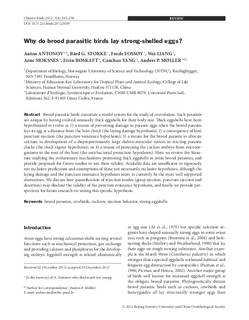| dc.contributor.author | Antonov, Anton Tinchov | |
| dc.contributor.author | Stokke, Bård Gunnar | |
| dc.contributor.author | Fossøy, Frode | |
| dc.contributor.author | Liang, Wei | |
| dc.contributor.author | Moksnes, Arne | |
| dc.contributor.author | Røskaft, Eivin | |
| dc.contributor.author | Yang, Canchao | |
| dc.contributor.author | Møller, Anders Pape | |
| dc.date.accessioned | 2017-10-27T08:17:28Z | |
| dc.date.available | 2017-10-27T08:17:28Z | |
| dc.date.created | 2013-01-16T07:52:31Z | |
| dc.date.issued | 2012 | |
| dc.identifier.citation | Chinese Birds. 2012, 3 (4), 245-258. | nb_NO |
| dc.identifier.issn | 1674-7674 | |
| dc.identifier.uri | http://hdl.handle.net/11250/2462506 | |
| dc.description.abstract | Brood parasitic birds constitute a model system for the study of coevolution. Such parasites are unique by having evolved unusually thick eggshells for their body size. Thick eggshells have been hypothesized to evolve as 1) a means of preventing damage to parasite eggs when the brood parasite lays its egg at a distance from the host clutch (the laying damage hypothesis); 2) a consequence of host puncture ejection (the puncture resistance hypothesis); 3) a means for the brood parasite to allocate calcium to development of a disproportionately large skeleto-muscular system in evicting parasite chicks (the chick vigour hypothesis); or 4) a means of protecting the cuckoo embryo from microorganisms in the nest of the host (the anti-bacterial protection hypothesis). Here we review the literature studying the evolutionary mechanisms promoting thick eggshells in avian brood parasites, and provide proposals for future studies to test their validity. Available data are insufficient to rigorously test exclusive predictions and assumptions of these not necessarily exclusive hypotheses, although the laying damage and the puncture resistance hypotheses seem to currently be the most well supported alternatives. We discuss how quantification of rejection modes (grasp ejection, puncture ejection and desertion) may disclose the validity of the puncture resistance hypothesis, and finally we provide perspectives for future research on testing this specific hypothesis. | nb_NO |
| dc.language.iso | eng | nb_NO |
| dc.publisher | BioMed Central | nb_NO |
| dc.rights | Navngivelse 4.0 Internasjonal | * |
| dc.rights.uri | http://creativecommons.org/licenses/by/4.0/deed.no | * |
| dc.title | Why do brood parasitic birds lay strong-shelled eggs? | nb_NO |
| dc.type | Journal article | nb_NO |
| dc.description.version | publishedVersion | nb_NO |
| dc.source.pagenumber | 245-258 | nb_NO |
| dc.source.volume | 3 | nb_NO |
| dc.source.journal | Chinese Birds | nb_NO |
| dc.source.issue | 4 | nb_NO |
| dc.identifier.cristin | 989521 | |
| dc.relation.project | Norges forskningsråd: 218144 | nb_NO |
| dc.description.localcode | © 2012 The Authors; licensee BioMed Central Ltd. This is an Open Access article distributed under the terms of the Creative Commons Attribution License 4.0 (https://creativecommons.org/licenses/by/4.0/), which permits unrestricted use, distribution, and reproduction in any medium, provided the original work is properly cited. | nb_NO |
| cristin.unitcode | 194,66,10,0 | |
| cristin.unitname | Institutt for biologi | |
| cristin.ispublished | true | |
| cristin.fulltext | original | |
| cristin.qualitycode | 0 | |

